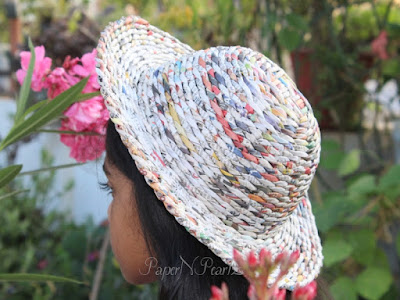A round storage box measuring 6 inches tall and 9.5 inches across is my latest foray into the art of newspaper weaving. For this container, I did not paint the tubes, but rather used the regular newspaper tubes with print, to weave the box. Once everything, including the lid, was completed, I painted everything with white acrylic paint. While I was able to get a good, white container, I must say it is much less tedious to paint the tubes before weaving! Painting the nooks and crannies of the completed object is really really tiresome.
Finally, to add some colour, I included some decoupage using decoupage napkins and I must say I love the effect.
The lid has a little bow on top, though it turned out a little too small. But it works as an effective handle.
As soon as the work was done and everything dried up and hardened, Little Miss came right along and picked up the container and declared that it was hers as she had absolutely nothing to store her things! 😄 So that was that. Apparently if I needed one for myself, I better make another one, this one was not available..





















